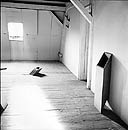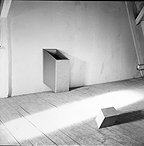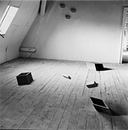 |
perspective cavalière /cavalier perspectives |
 |
 |
 |
Vues d'atelier / in my studio |
 |
Pour agrandir les images cliquer dessus / To enlarge pictures please click on them |
 |
|
 |
|
 |
|
Objets spécifiques
Les modes
de représentation des objets sur des supports plans sont toujours des
conventions reconnues pour leurs capacités à informer sur la
volumétrie. Le décryptage de l'objet graphique permet la compréhension
spatiale de ce qu'il est censé représenter, comme la partition
permet au musicien initié d'imaginer la musique.
Dans le cas d'une perspective conique, la représentation se veut illusionniste
et prétend rendre l'image de la réalité. Mais, comme
pour les dessins techniques où les conventions sont partagées
par les différents membres d'un même groupe professionnel qui
doit pouvoir les utiliser sans les interpréter, les perspectives parallèles
ou cavalières ne prétendent pas donner l'image observée
de la réalité, mais offrent le plus d'information possible sur
les caractéristiques physiques et volumétrique de l'objet représenté,
permettant la mesure directe sur le plan.
Pour les séries des "objets spécifiques", j'ai un
peu inversé la règle. Ainsi, les formules qui président
à la construction dessinée d'un volume ont été
utilisées, non pas pour un dessin mais pour construire des volumes
simples. En se déplaçant autour de ces objets étranges,
à un moment, l'axe de vision donne une image qui coïncide avec
le souvenir du dessin d'un parallélépipède rectangle.
Malgré la perception première de la réalité de
la volumétrie observée, le cerveau préfère corriger
et se rassurer en interprétant la forme pour la faire entrer dans le
répertoire des formes connues.
Specific objects
The means
of representing objects on plane supports always consist in conventions that
are well-known for their ability to inform us about volumetry. Deciphering
the graphic object permits the spatial understanding of what it is supposed
to represent, in the same way the score permits the initiated musician to
imagine the music.
In the case of a conical perspective, representation claims to be illusionist
and pretend to draw the picture of reality. The fact is that, in technical
drawings, conventions are shared out between the different members of one
professional group who must be able to make good use of them without interpreting
them. Then, as for these technical drawings, parallel or cavalier perspectives
are not supposed to draw an observed picture of reality, but they give most
information as possible about physical and volumetric features of the present
object. This permits the direct measuring of the plane.
Concerning the series of “specific objects”, I have reversed the
rule a little. Thus, formulas governing the drawn figure of a volume have
been used for the construction of simple volumes, not for a drawing. Then,
the vision axis turns round these strange objects and at one moment it gives
a picture which coincides with the souvenir of the drawing of a rectangle
parallelepiped. Despite the first perception of the reality of the observed
volumetry, the brain prefers to correct and to get reassured so that it interprets
the form in order to make it be part of the list of the well-known forms.
Stéphane Lallemand
Objets spécifiques / Specific objects (1988 - 1989).....
 |
perspective cavalière /cavalier perspectives |
 |
 |
 |
Vues d'atelier / in my studio |
 |
Pour agrandir les images cliquer dessus / To enlarge pictures please click on them |
 |
|
 |
|
 |
|